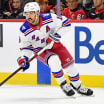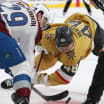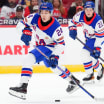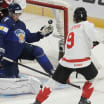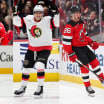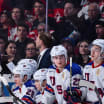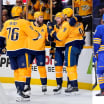Mailbag: 2020 Draft dark horses, Rangers future moves
NHL.com's Dan Rosen answers weekly questions
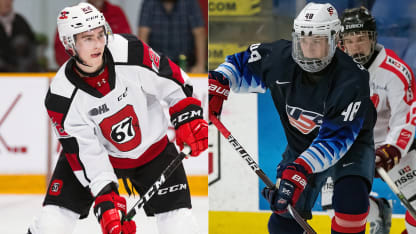
In this year's draft class, who is your dark horse to maybe jump up and be selected early, much like when the Detroit Red Wings took Moritz Seider at No. 6 in 2019? -- @theashcity
I'm not going to pretend that I'm a draft expert here, but your question piqued my interest and had me wondering the same thing. I am always a sucker for a good dark horse story and Seider certainly was that last season. Most draft experts, including our three at NHL.com -- Mike G. Morreale, Adam Kimelman and Guillaume Lepage -- had the defenseman going in the first round in their mock drafts last year, but few, if any, had him in the top 10.
Since we collaborate on a lot of projects at NHL.com, I enlisted Mike's help for this answer because he constantly is talking to scouts while reporting on and watching draft-eligible players. Nobody covers the NHL Draft quite like he does, and Morreale targets defenseman Jake Sanderson from the USA Hockey National Team Development Program Under-18 team, and forward Jack Quinn of Ottawa in the Ontario Hockey League.
Of Sanderson, the son of former NHLer Geoff Sanderson, Morreale said he made a great impression on him at the 2020 USA Hockey BioSteel All-American Game on Jan. 20.
"I'm not sure if he's considered just outside the top 10 right now, but I think someone could step up and take him top eight," Morreale said. "What makes this interesting is that, right now, Jamie Drysdale of Erie is the top defenseman available on the draft board, but Sanderson has been so good down the stretch."
Here is Morreale's story about Sanderson from Feb. 20:
Sanderson could rank among best-ever defensemen at NTDP
Of Quinn, Morreale said the forward has elevated his draft standing after finishing second in the OHL with 52 goals and eighth with 89 points. He scored 15 power-play goals and 240 shots on goal, each first on Ottawa.
"He's smart with the puck, shows a lot of poise, and plays a real responsible two-way game," Morreale said. "I think there's tons of upside potential and someone may take chance on him inside the top 10."
Do you think the New York Rangers need to get one more ELITE player to get over the hump? And does Igor Shesterkin become the No. 1 goalie? -- Reiku78
Every team will say it needs one more top player. The Rangers are no different in that regard. Realistically, though, they need their young players to develop into top players. They need rookie forward Kaapo Kakko, the 19-year-old who was the No. 2 pick in the 2019 NHL Draft, to develop the way forward Andrei Svechnikov did from Year 1 to Year 2 for the Carolina Hurricanes. Svechnikov, the 20-year-old who was the No. 2 pick in the 2018 NHL Draft, had 37 points (20 goals, 17 assists) in 82 games as a rookie last season and 61 points (24 goals, 37 assists) through 68 games this season. Kakko, who has shown flashes of his potential, has 23 points (10 goals, 13 assists) in 66 games. He should be the Rangers' next elite player. New York also needs center Filip Chytil to continue his development and become more of a scoring threat. He has made great strides this season in many areas, including knowing how and when to use his strength and get to the net. His production has followed to a degree; he has 23 points (14 goals, nine assists) in 60 games after scoring 23 points (11 goals, 12 assists) in 75 games last season. The Rangers need Chytil to become more of a 50-60-point player. They also need the continued maturation of defensemen Adam Fox and Ryan Lindgren, who look like they have the ingredients to be a top pair for a long time. Shesterkin, who already is the new No. 1 goalie, needs to continue to develop into the role. He has the makings of a future all-star. Still to come is the development of forward Vitali Kravtsov, and defensemen K'Andre Miller, Nils Lundkvist, Matthew Robertson and Yegor Rykov. So, yes, the Rangers would love another elite player, but they should already have at least one more in their organization. They don't need to sign another one like they did forward Artemi Panarin last offseason, they need to patiently wait for one to develop.
Panarin lighting it up for Rangers so far
Can the Colorado Avalanche's rapid turnaround be replicated by other teams or did general manager Joe Sakic catch lightning in a bottle more than once? -- @jtthenutt
Rapid is not a word I would use for the Avalanche turnaround. It has, in fact, taken several years for them to get to this point. Sakic started running the hockey operations department on May 10, 2013, and 51 days later the Avalanche selected forward Nathan MacKinnon with the No. 1 pick in the 2013 NHL Draft. They hit an unsustainable high in the 2013-14 season by finishing with 112 points only to lose to the Minnesota Wild in seven games in the Western Conference First Round. That team was nowhere near as good as 112 points would suggest. They didn't possess the puck a lot and they relied on their goaltending to bail them out too often. They went down to 90 points the following season, 82 the season after, and bottomed out at 48 points in 2016-17, when they were not nearly as bad as their record because they still had the makings of a core with MacKinnon and forwards Mikko Rantanen and Gabriel Landeskog. Sakic has done a good job of filling in around that core in the past several seasons, and the addition this season of rookie defenseman Cale Makar, who was the No. 4 pick in the 2017 NHL Draft, has made a huge difference. But to say this has been a rapid climb to the Avalanche being Stanley Cup contenders wouldn't be accurate in my opinion. The Avalanche this season, with 92 points in 70 games, have been bolstered by strong moves made in the offseason to acquire forwards Andre Burakovsky, Nazem Kadri and Joonas Donskoi and put them around the many players already in place, a roster they have been building for several seasons.
COL@CBJ: Kadri snaps home tying goal
What rule changes would you like to see next year? I would like to see the ability to ice the puck on the penalty kill taken away. -- @HHIGirl72
I'm in agreement with you regarding icing on the penalty kill by the shorthanded team. This isn't a rule change under consideration as far as I know, but I would be interested in hearing a discussion on it among the general managers. The thing is, it wouldn't be a small change. It would materially change how teams would kill penalties. Teams would have to adjust how much they pass or skate the puck out of the defensive zone without the ability to shoot the puck down the ice and change the penalty killers on the fly. It also doesn't stop you from icing the puck. You'd still be able to do that, but you'd face the same consequences as a normal icing in that the whistle would blow, the face-off would be in your defending zone, and you wouldn't be able to change players, meaning tired penalty killers could be left on the ice. But tired players and attempts to pass or skate the puck across the red line for a dump in creates the opportunity for turnovers that lead to offense. The NHL has for years now been making rule changes to benefit offense and this would be another one.
I'm very much in favor of eliminating foot-in-the-air offside calls on video review. The general managers feel the same way. They voted at their meeting on March 3 to make a recommendation to the NHL/NHLPA Competition Committee that the application of the offside rule change to allow players to be considered onside as long as one of their skates is above the vertical plane of the blue line regardless if it is in contact with the ice. The hope among the GMs is that changing the rule to a more liberal interpretation of offside will lead to fewer coach's challenges and that would lead to more goals being allowed to stay on the board. That means more offense, and that's good.
While I'm not bullish on this last one, it would be intriguing to me to hear about penalties in overtime being reduced to one minute for a minor. Overtime is a maximum of five minutes and an argument could be made that it is too punitive to put a team on the penalty kill for two of those minutes, or potentially 40 percent of the OT session.

